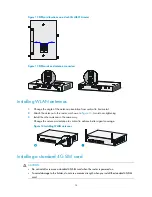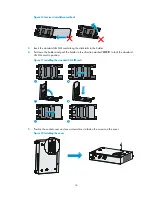
2
•
Always wear an ESD wrist strap when installing the router.
•
Do not stare into an open optical interface. The light can cause permanent eye damage.
•
Use a good grounding system. This is essential for reliable operation.
•
Confirm that the resistance between the chassis and the ground is less than 1 ohm.
European Union Commission Regulation 1275/2008
The power data for affected products—including the power consumption of the product in networked
standby if all wired network ports are connected and all wireless network ports are activated—is
provided in section P14, “Additional information,” of the product IT ECO Declaration available
at
http://www.hp.com/hpinfo/globalcitizenship/environment/productdata/iteconetworking.html
.
Site requirements
The router can only be used indoors.
This section provides information about temperature, humidity, cleanness, and air quality requirements,
as well as rack-mounting requirements and protection against damage from lightning and EMI.
Table 2
Temperature and humidity requirements
Temperature Relative
humidity
0°C to 40°C (32°F to 104°F)
5% to 90%
Table 3
Dust concentration limit in the equipment room
Substance
Concentration limit (particles/m
3
)
Dust particles
≤
3 x 10
4
(No visible dust on desk in three days)
NOTE:
Dust particle diameter
≥
5
μ
m
Table 4
Harmful gas concentration limits
Gas Max.
(mg/m
3
)
SO
2
0.2
H
2
S 0.006
NH
3
0.05
Cl
2
0.01
To prevent overheating:
•
Provide adequate clearance for air flow, including at least 10 cm (3.94 in) ventilation space
around the router's air intake and outlet vents.
•
Make sure the site has an adequate cooling system.








































